Chapter Five: Cycling in Southern India—Karnataka, Kerala, and Tamil Nadu
Subject: Nine Degrees North
Date: Sun, 10 Feb 2002 13:31:44
Fort Cochin,
Kerala, India
The pair of elephants trumpeted and the temple band played as an image of Sri
Krishna came out on a golden palanquin for a ride around the block. It was evening
in the Vaishnavaite town of Udupi near the coast of Karnataka state. Once outside
the temple, Sri Krishna was placed on a larger palanquin with lights and the procession
began. None of the devotees were more devout than the elephants, who walked backward
as they faced Krishna and waved fly whisks from their trunks.
This is South India, and the change was noticeable right after crossing the border
from Goa. Gone were the road signs in Hindi, replaced by the pretty curved letters
of the Kannada alphabet, the official language of Karnataka.
This and other states of the far south use the Dravidian group of languages—very
different from the Indo-Aryan group of the north. English seems to find more favor
as a national language in the south, which works to the advantage of us non-Hindi
speaking visitors. Many people had much darker skin than up north. This must be
handy to protect themselves from the sun, which was getting fiercer as I wound south.
It only took several days to cross Karnataka to the long, green state of Kerala.
It’s famed for the Keralans’ domestic progress and international outlook.
Unlike most of the rest of India, education has long been considered important,
and the literacy rate is about 90%, far higher than the dismal figures in most other
states, where less than half the rural folk have a chance to learn to read and write.
The Keralans have achieved greater economic equality, including experiments with
Communism—there are lots of red flags with the hammer and sickle out to promote
the Communist Party!
Cut off by high mountains from the rest of India, the Keralans look to the sea
and distant lands—many of the men work overseas. Missionaries have long been
at work here. It’s said that the apostle Doubting Thomas arrived on the Keralan
coast around 50 A.D. The later Portuguese, Dutch, and British had success as well.
Muslim missionaries arrived too. Now Kerala is about 60% Hindu, 20% Christian, and
20% Muslim. People here are very friendly, and I hear a constant stream of “hellos”
as I cycle by.
Fellow Western cyclists have been few and far between—an overheated German
couple who had cycled from Varanasi to Goa, a plucky pair of Brits cycling on one-speed
Indian bikes from Kerala to Goa, and the American (the first I’ve met cycling
in India!) Mike Vermeulen on a loop around South India. Mike had also ridden around
Australia—a really big trip—among other lands. You can read about his
adventures at www.mvermeulen.com/oneyear/india.htm.
Another website with a South India cycle tour and some illustrated reasons why cycling
here beats out other forms of transport is Mr. Pumpy’s
www.mrpumpy.net/rides/9-india-south/BSA-India-1.html.
Now Bessie Too and I are about half way down the coast of Kerala. Cochin is full
of old Portuguese and Dutch buildings and home to a diminishing Jewish community
(said to be about 20). The synagogue here was first built in 1568 and rebuilt in
1664 after the Portuguese blasted it in a raid. Jewish traders are said to have
arrived in the 1st century A.D. to participate in the spice trade.
Cochin is spread across the mainland, a peninsula, and some islands, but most
of the historic sites, museums, and atmosphere are here on the peninsula of Fort
Cochin and Mattancherry. I’ve taken in a traditional Kathakali dance, in which
the main character dresses up in elaborate makeup and clothing and uses eye movements
and pantomime gestures to act out (very slowly) the plot. The St. Francis Church
here dates back to 1503 and is said to be the oldest European-built church in India.
The synagogue is a popular destination too, and is filled with oil lamps and Chinese
floor tiles. The 1555 Mattancherry Palace has some fine murals of Hindu epics. I
also got out of town for a village backwater cruise in a large wooden canoe; it
was very peaceful to glide across the still waters of canals and a river amongst
the greenery, village life, and birds.
Now for something completely different...Bessie Too and I plan to head for the
hills and Kerala’s highest hill town, Munnar, at 1524 meters (5000 feet),
then south to the wildlife park at Periyar. After the hills, we’ll do some
more backwater cruises near the coast. Time is running out—I have only until
about the end of this month before the trip is over. But there will be a next cycle
tour.
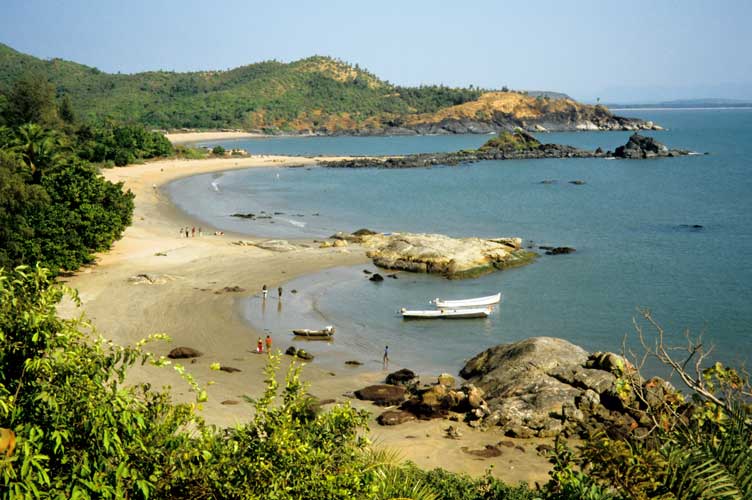
Om Beach, near Gokarna in Karnataka state
The temple town of Gokarna is a popular
stop for travelers because of its pleasant atmosphere and the many beaches nearby.
I hiked to Paradise Beach and back, a fine day trip. You'd never suspect from
this photo that there's an Internet cafe tucked back in the trees to the left!
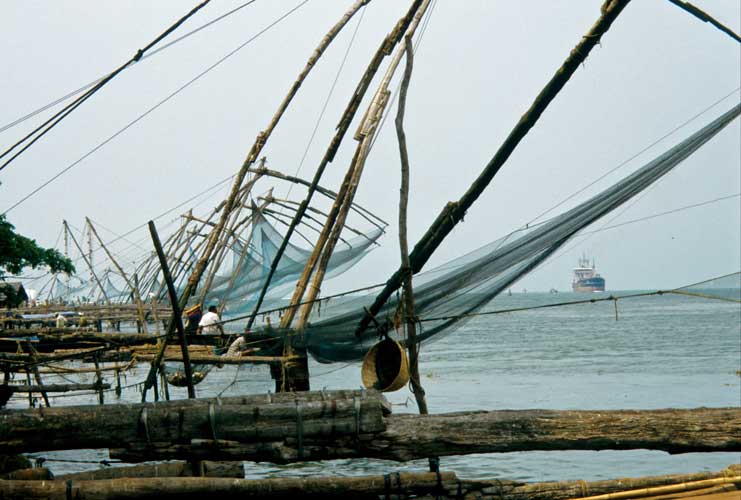
Chinese fishing nets line the north shore of the Fort Cochin. It takes several men
to lower and raise each cantilevered net.
Traders from the court of Kublai Khan
are said to have introduced the design.
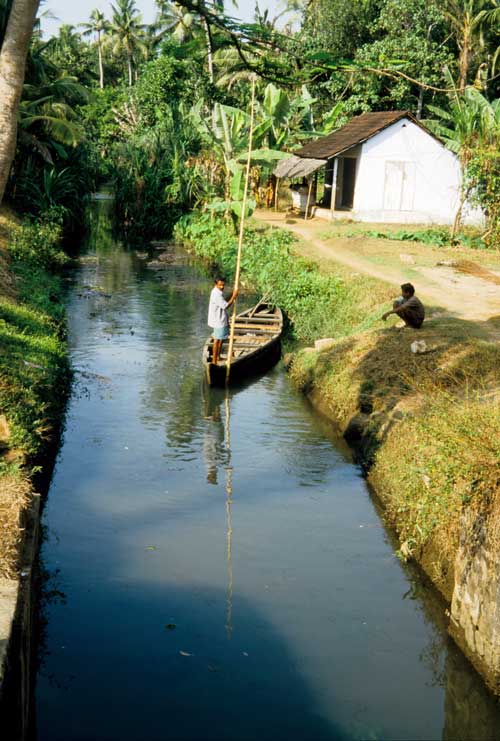
Canal life, seen on a backwater tour by canoe, about 50 km southeast of Fort
Cochin.
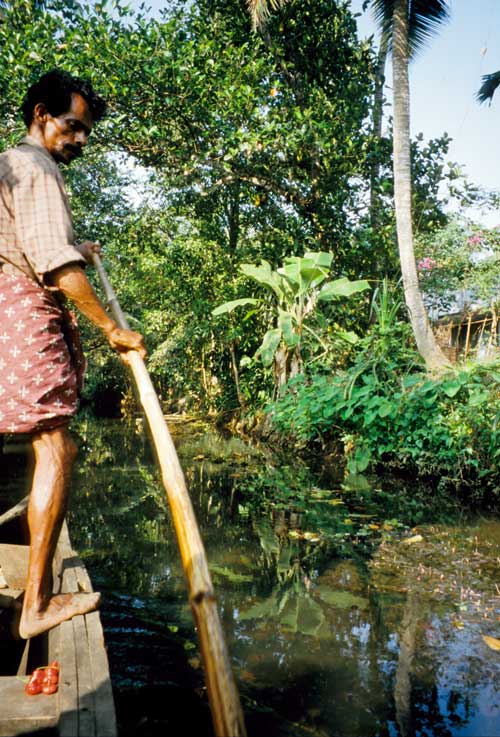
Our boatman on a backwater tour by canoe about 50 km southeast of Fort Cochin.
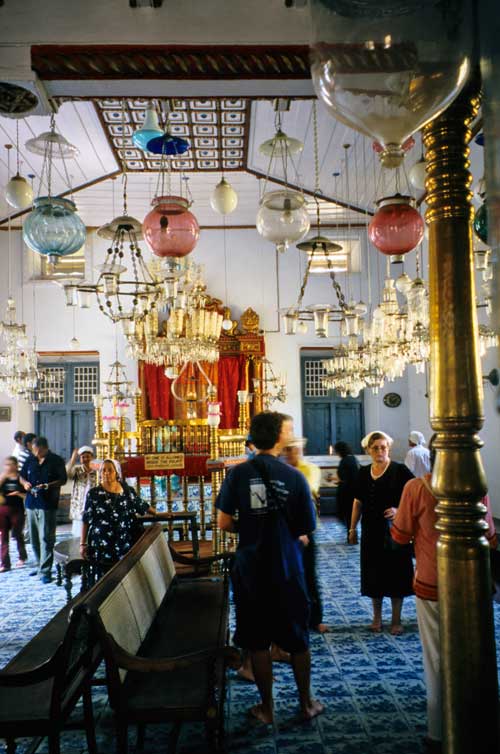
Pardesi Synagogue in Mattancherry; spice merchants still operate businesses on nearby
streets.
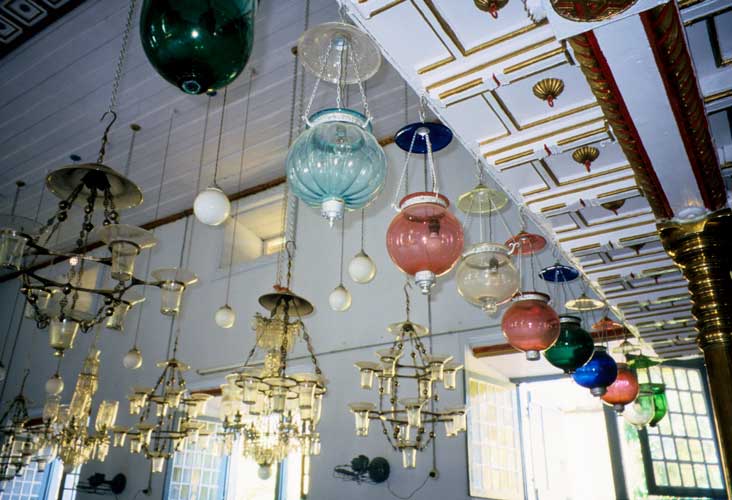
The colored glass oil lamps in Pardesi Synagogue come from Belgium.
When in use,
a wick floats on oil over a layer of water.
Subject: mountains and monkey business
Date: Fri, 15 Feb 2002 14:42:08
Kumily (Periyar Wildlife Sanctuary), Kerala, India
Ahhh, a cool breeze feels so good! Two days of pedaling and plenty of climbing
took me from the hot coast at Fort Cochin into the towering hills, emerald green
tea plantations, and azure skies of the Western Ghats. I like its old name best—the
High Range of Travancore.
At Munnar, Kerala’s highest hill town (1524 meters or about 5000 feet),
I decided to go even higher. Yes, call me a “mountain nut”! So I cycled
to a pass on the Tamil Nadu border called Top Station, enjoying great views of the
mountains, lakes, forests, and lots of tea plantations on the 68-kilometer round-trip.
The next day I went for even MORE hills on the ride south to Kumily. Two big
passes in tea country, then lots of ups and downs through forests near the headwaters
of the Periyar River. It was a tough and exhilarating 106-kilometer ride. Spice
plantations are up here too—I saw lots of long-leaved cardamom nestled in
the shade of the forests. I like riding through forests as they have such sweet
smells, Many trees are now in bloom with bright red or violet flowers.
Today I went looking for wildlife at nearby Periyar. A boat cruise on the lake
in the early morning passed by otters frolicking in the shallows, sambar deer, boar,
wild elephants, turtles, and black langur monkeys. I saw lots of birds, such as
the turquoise-colored lesser kingfisher and the water-loving snake birds and cormorants.
Next I went on a four-hour hike into the forest amongst some huge trees. Black langur
monkeys played in the tree tops and butterflies fluttered across the meadows. A
late afternoon boat ride turned up some of the same animals as in the morning, plus
a huge gaur (bison).
Tomorrow I plan to ride down, down, down to Kottayam, then spend a couple relaxing
days of riding boats on Kerala’s backwaters, the placid network of lakes and
rivers that extends along much of the south coastal region.
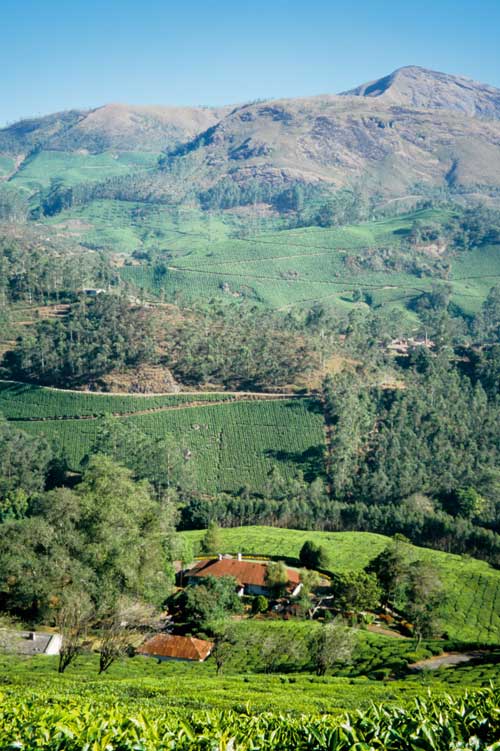
Expansive views on a ride among the tea plantations of the Western Ghats
near Munnar
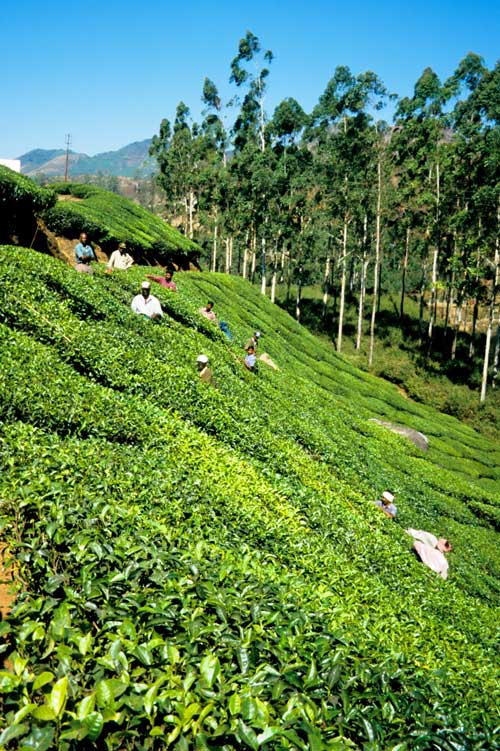
Picking tea in Western Ghats
near Munnar.
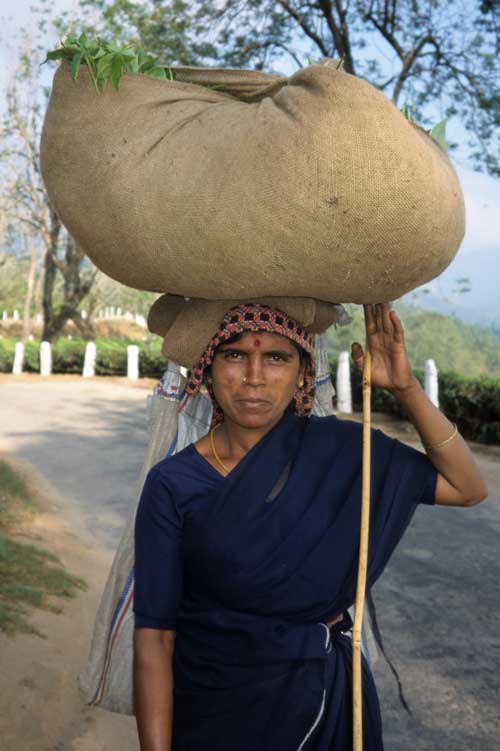
Heading home with the tea harvest
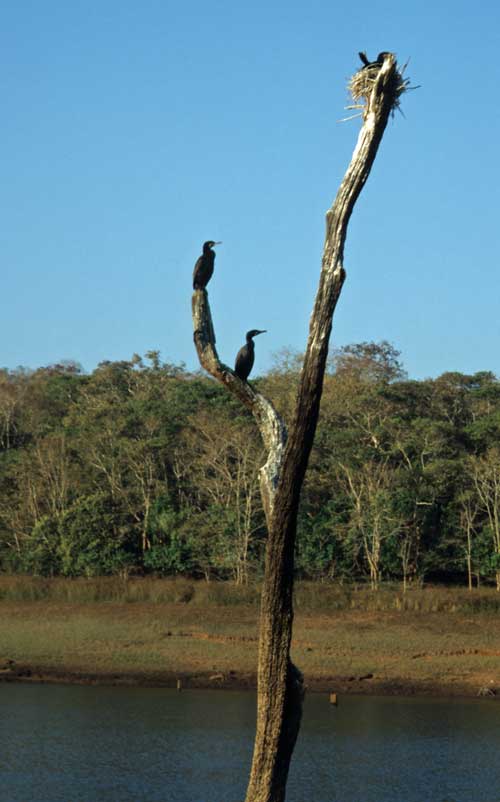
I passed these cormorants on a boat tour in Periyar Wildlife Sanctuary.
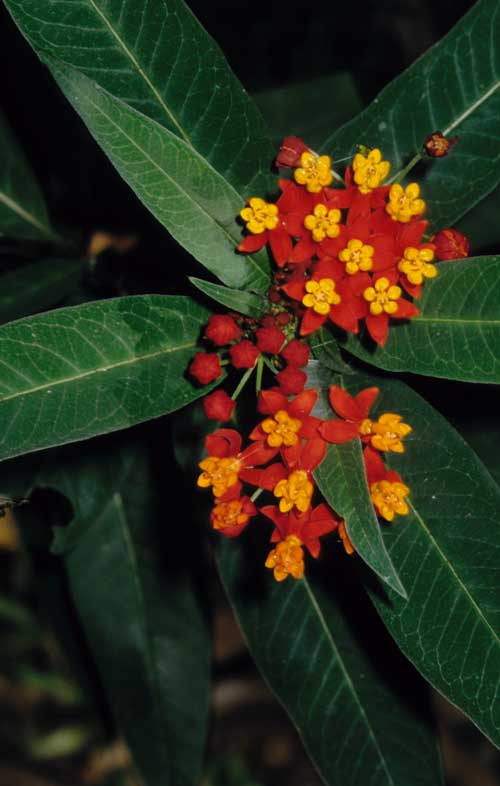
A jungle hike in Periyar Wildlife Sanctuary led past these little flowers.
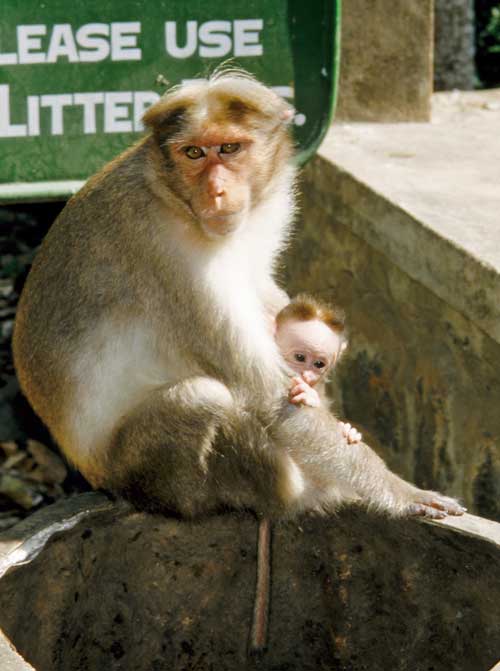
Hanging out atop the rubbish bin at Periyar Wildlife Sanctuary.
Subject: Explosive Devotions
Date: Wed, 20 Feb 2002 17:16:16
Varkala,
Kerala, India
The long ride down from the mountains had plenty of ups and downs with one whopper
downhill halfway. I hit the backwaters again the next day, this time in a motor
launch out of Kottayam. Sitting on the roof under a canopy with a cooling breeze,
I watched the intense green of Kerala glide by. Villages lined the canals and the
boat had to wait for drawbridges to open. Lots of birds—many of the same species
seen at Periyar Wildlife Sanctuary in the hills—hung out around the water
waiting for a fish to swim by. A stop at a bird sanctuary didn’t turn up many
birds (it was midday), but I found hundreds of big fruit bats chattering noisily
while hanging from branches of a tree.
A sign outside a church in Old Goa asked visitors to maintain silence and—just
in case people didn’t get the picture—concluded “Do not set off
firecrackers.” Well, no such sign existed outside the Hindu temple at Haripad.
I paid the vedi man there 6 rupees for a big firecracker. He filled an iron shell
with black gunpowder, plugged the opening with crushed rock, added some powder to
the ignition hole, lit the powder, then BANG. I’m sure the gods were pleased
with the loud noise. Keralan temples tend to be simple affairs. The main shrine
in the central courtyard has a conical roof or perhaps a small tower. A sacred tree
and small shrines to other gods lie around the courtyard. Keralans like to use lots
of oil lamps in worship, both in a family shrine at home and in the temple. Hundreds
of oil lamps on the exterior of the main shrine blaze during festivals. Besides
the firecrackers outside, the sanctuary echoes with bells, drums, and nadaswaram
(a long oboe-like instrument).
A big Hindu festival today had lots of color, lights, and noise. A procession—the
main event—lasted over three hours with bands, dancers, floats (with Hindu
gods), and 20 caparisoned elephants put on a big spectacle. As darkness fell, countless
colored lights illuminated the scene.
Tomorrow I pedal into Kerala’s capital and main town, Trivandrum, to see
about an air ticket to Bangkok for next week. Currently I’m waitlisted. Then,
just one more day south to the very end of the road at Kanyakumari!
Alas, the trip really seems to be coming to an end. Bessie Too has held up well
during the ride. She had one tube go (there was a spare) and one tire give out.
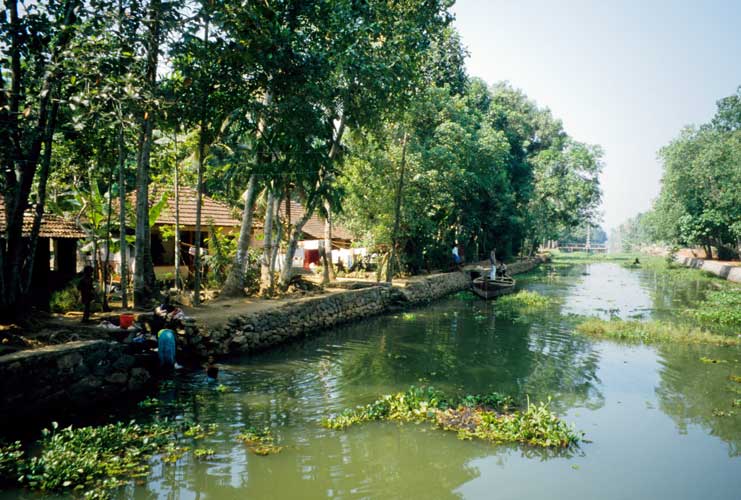
At the beginning of a backwater trip out of Kottayam I had to wait for some pedestrian
drawbridges to open on this canal.
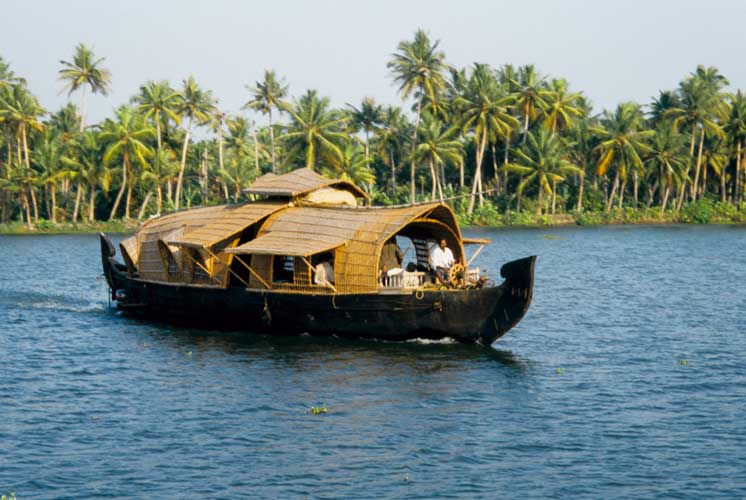
You can hire "riceboats" like this to explore the backwaters on overnight
trips.
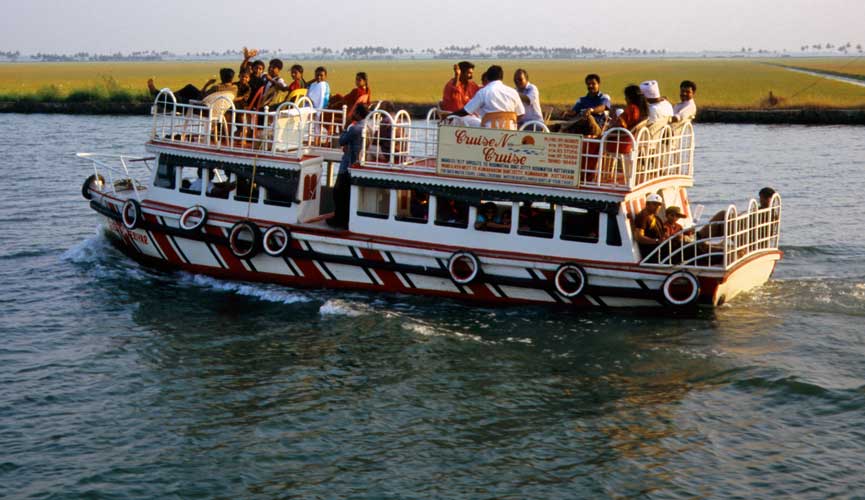
I was traveling the backwaters on a boat like this. The cruise was very relaxing.
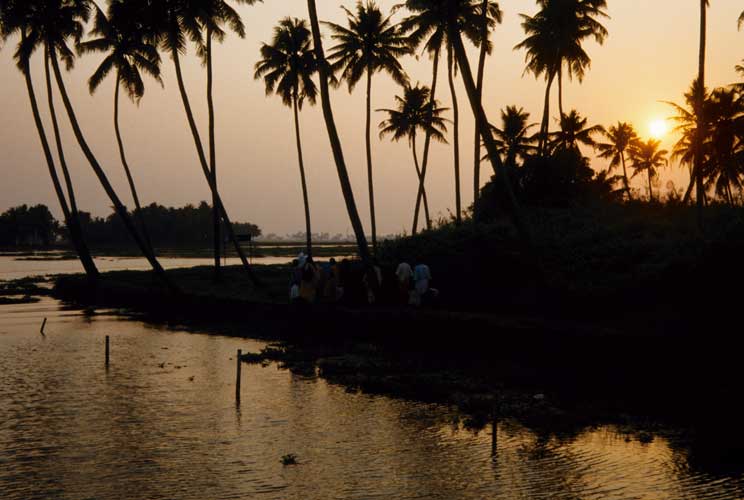
Heading home on the backwaters
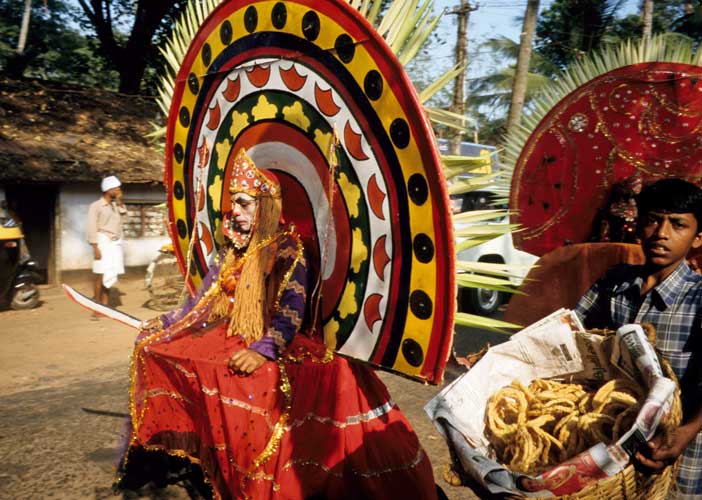
I encountered this temple procession outside of Varkala in Kerala state.
The
enterprising boy on the right is selling rings of fried bread.
This is more of the same procession. A much bigger one would take
place tomorrow.
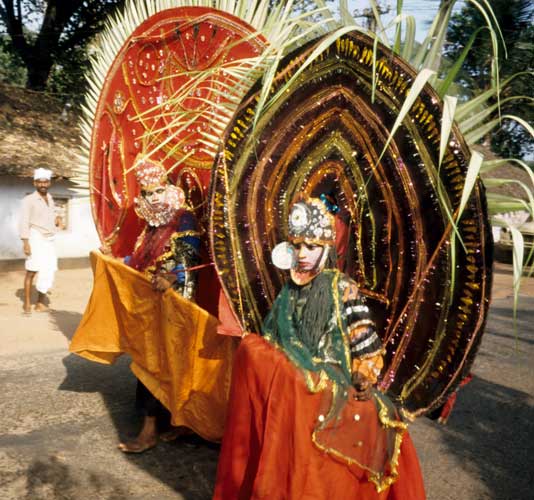
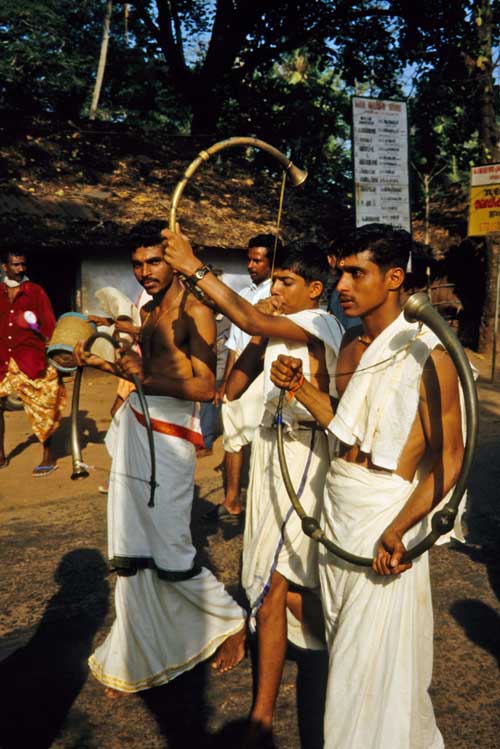
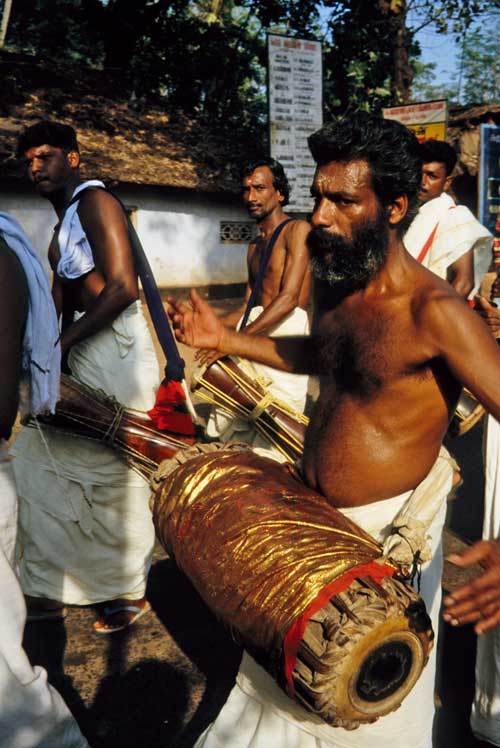
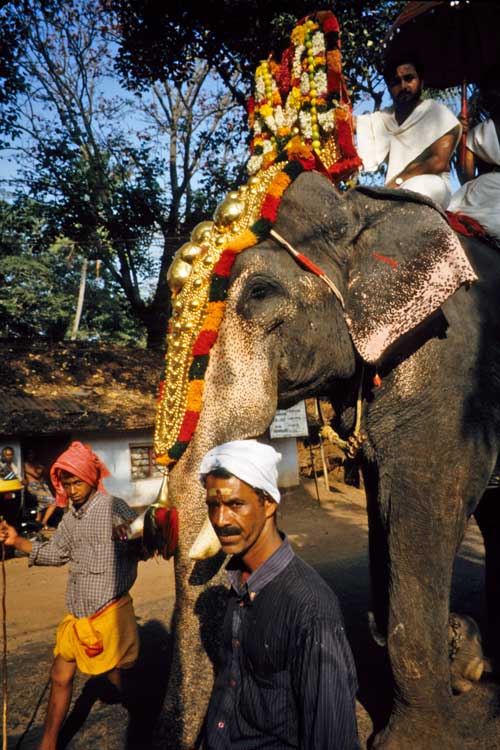
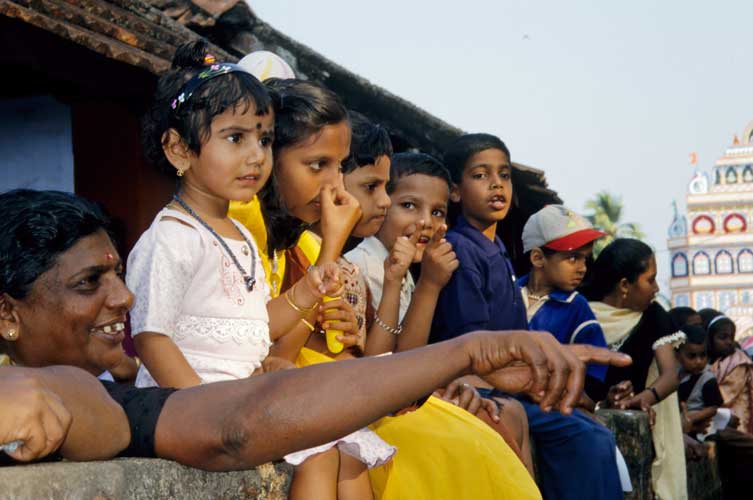
The temple procession on the following day included 20 elephants (including the
baby one pictured below), many bands, dance groups, floats, girls with temple offerings,
and priests. Huge multistoried gateways, such as the one on the right edge of this
picture were set up just for the event. The procession lasted more than three hours
and ended after sunset at a temple, lit by countless oil lamps.
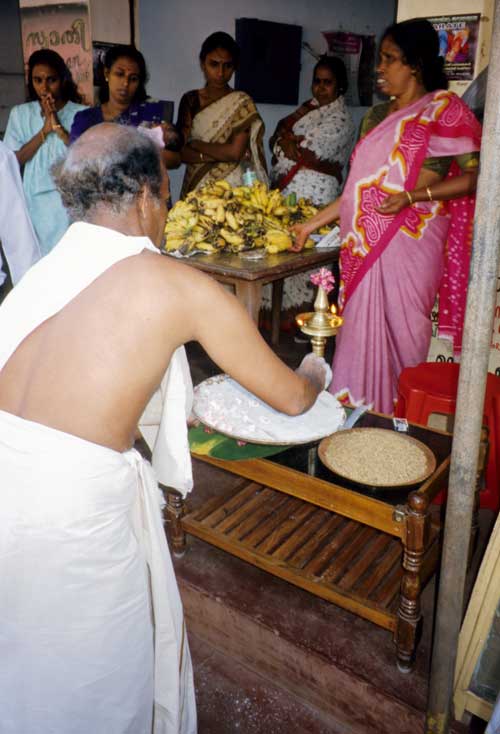
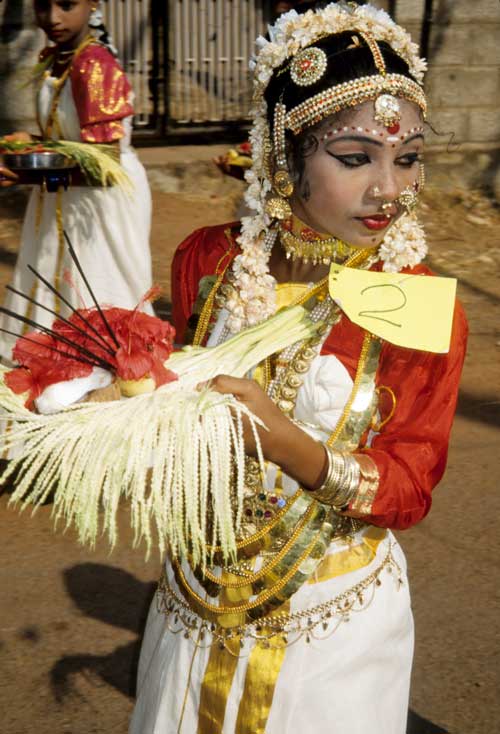
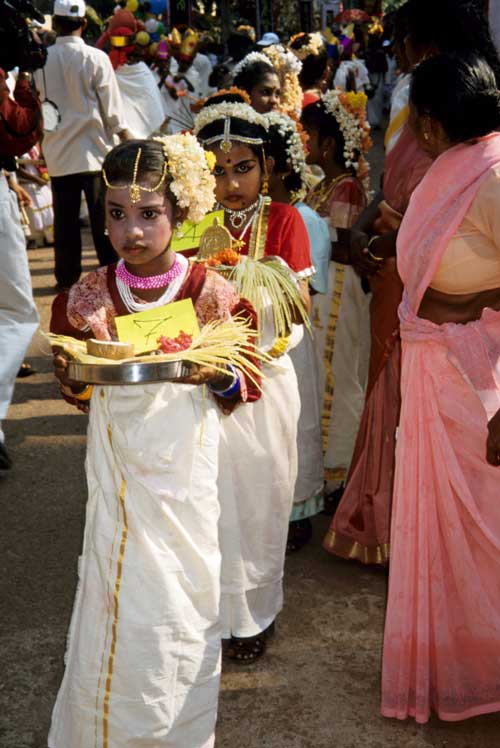
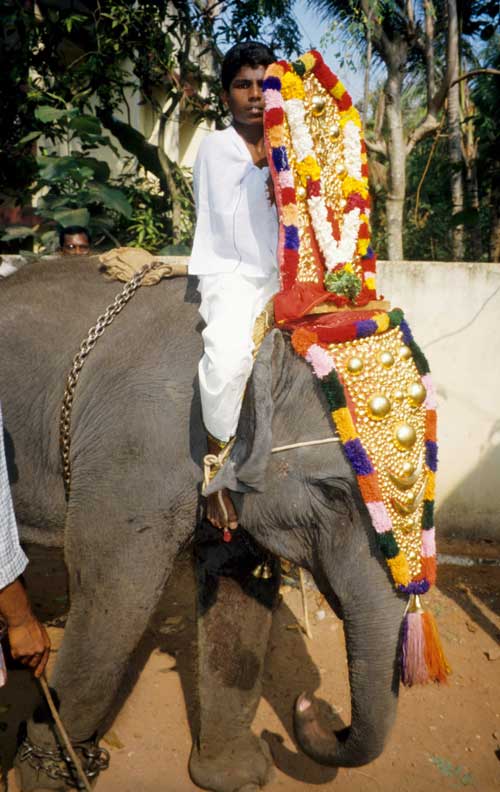
Subject: The End of the Road
Date: Sat, 23 Feb 2002 15:39:53
Kanyakumari,
Tamil Nadu, India
Every trip has its end, and Kanyakumari—or Cape Comorin—marks the
end of this long ride. Bessie Too and I have been traveling for more than five months
now, riding ever farther south. Kanyakumari seems a fitting end point, since it
is the southernmost point of the Indian subcontinent and a sacred spot. The waters
of the Bay of Bengal, Indian Ocean, and Arabian Sea meet here. For Hindus, the site
is also important because Devi, an incarnation of Shiva’s wife, vanquished
some nasty demons who threatened the world. Devi in this incarnation followed Vishnu’s
advice of remaining a virgin in order to have the strength to save the world. A
priest took me through the stone halls of the temple here to see the main image
of the goddess; her face was covered in sandalwood paste.
A more recent figure, Swami Vivekanada, arrived in the early 1890s after extensive
wanderings as a monk through India. He swam across to a barren stone island just
offshore and meditated there for three days, recollecting his experiences of India
and what he should do next. He hoped to improve the lives of people by revitalizing
their Hindu religion. A museum tells the story of his wanderings, and a set of temple-like
buildings on the island commemorate his visit there. The temple and memorials attract
large numbers of pilgrims to town, who also gather to watch the sunrises and sunsets
across the water. Some visitors also enjoy a swim in the warm tropical surf.
Tomorrow Bessie Too and I turn north back to Trivandrum. Our flights via Sri
Lanka are confirmed now, for Wednesday and Thursday with an overnight in Sri Lanka.
After a long weekend in Bangkok we journey across the Pacific via Taiwan to San
Francisco on the following Monday.
The long ride has been a great experience, and this being India, there have been
lots and lots of experiences! Even though this is my seventh visit here and fifth
cycle ride, I certainly don’t feel that I’ve “seen” India.
If all goes well, I’ll be back with Bessie Too in late summer for a thrilling
ride in the heights of the Ladakh Himalaya at the far north end of India. Pakistan
will figure in a future—as yet unplanned trip. I’d like to do more cycling
there and some trekking.
Freedom to go where I pleased (thanks to Bessie Too) and the gift of so many
months helped the journey to unfold so well. China didn’t work out because
of the new non-cycling policy there (not related to Sept. 11th), and
I would have liked to stay longer in Pakistan, but the extra time in India came
in handy. I also had the freedom to end the trip anywhere, as I’d arrived
on the subcontinent via a one-way ticket (cheap too) purchased in Bangkok.
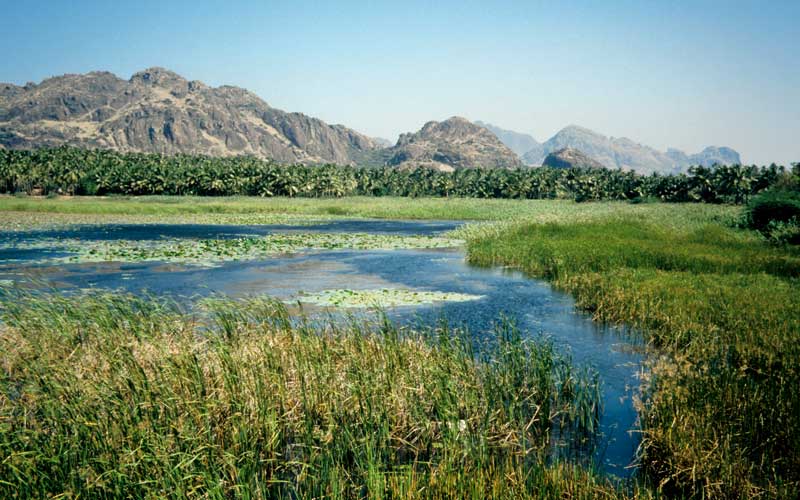
This is the south end of the Western Ghats, a range that extends nearly the length
of India's west coast.
We're in Tamil Nadu state now and just a short
ride from the southern extremity of India.
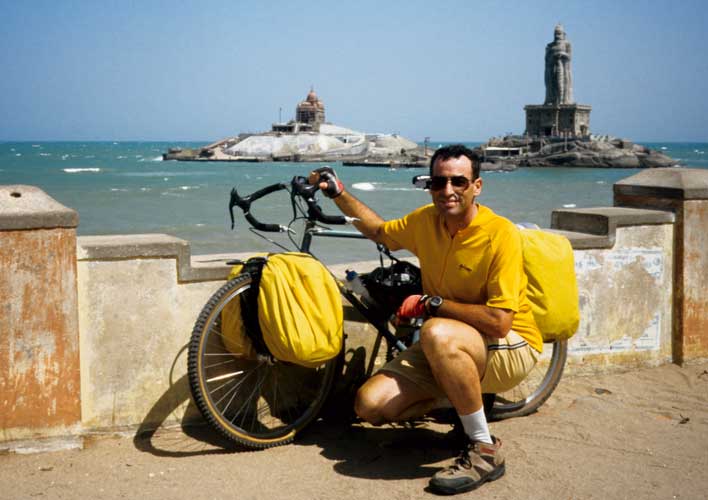
Bill and "Bessie Too the Bicycle" at the end of their ride in Kanyakumari.
The island just offshore on the left has a Memorial to Swami Vivekananda, who swam
across in 1892 to meditate before setting out across India to live a life of service
as a wandering Hindu monk. The giant statue on the island to the right honors a
Tamil Nadu poet. Sri Lanka is just beyond the horizon.
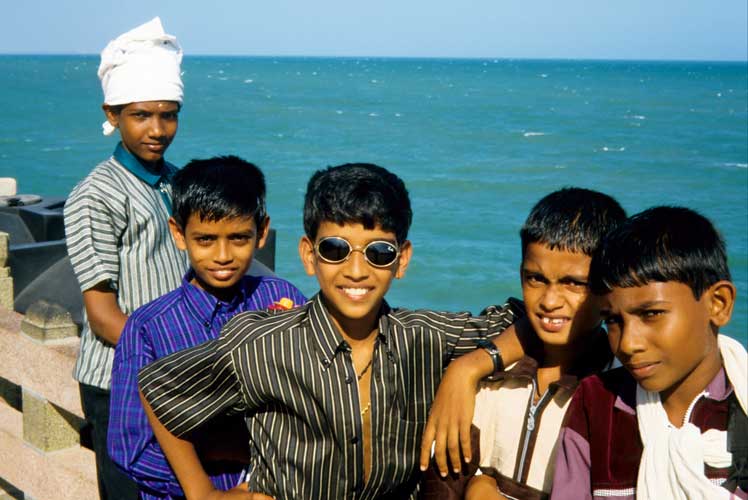
Kids at the Vivekananda Memorial
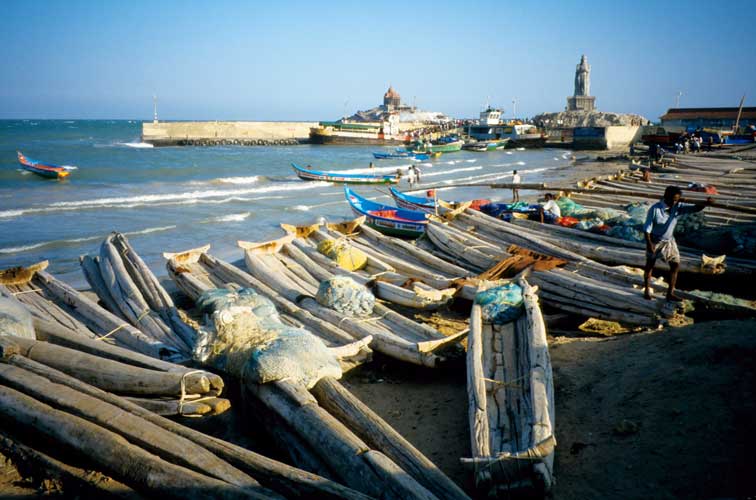
Fishermen sail and paddle these small raft-like boats in the rough waters where
the Arabian Sea, Indian Ocean, and Bay of Bengal meet.
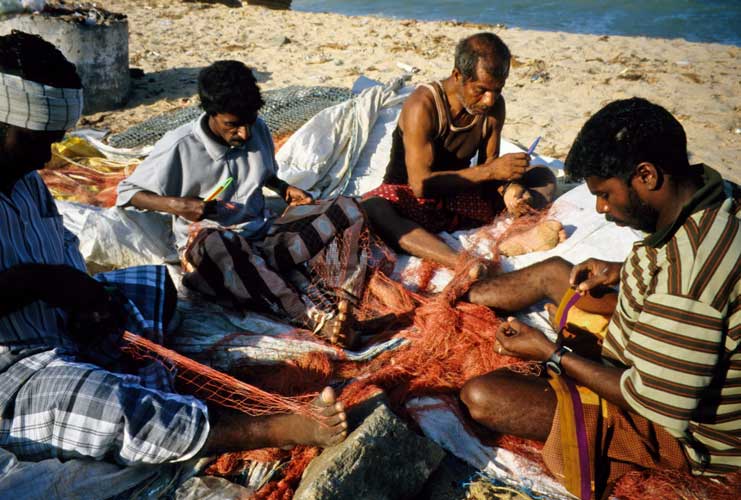
Most of the people in this village are Christian.
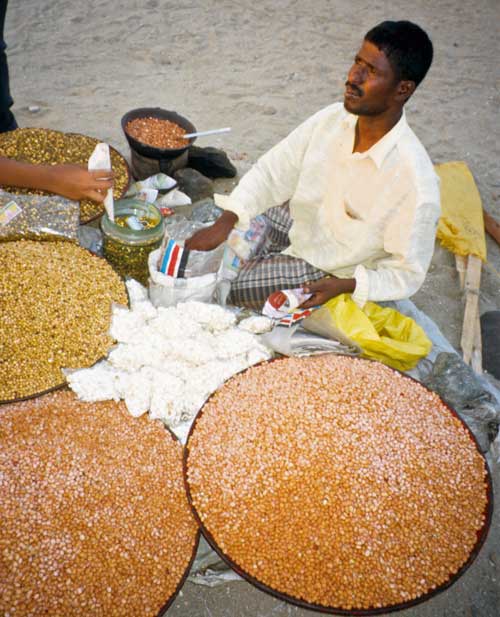
Get your peanuts and snacks on the beach.
The end of the day at the end of India—Kanyakumari, Tamil
Nadu
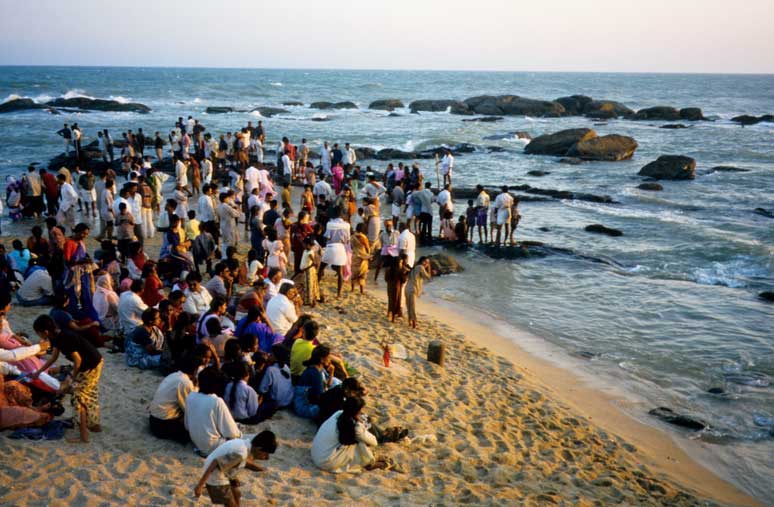
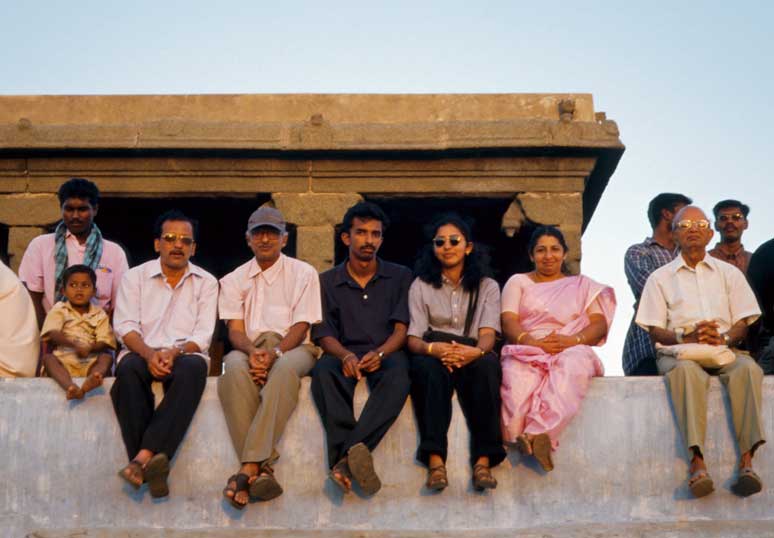
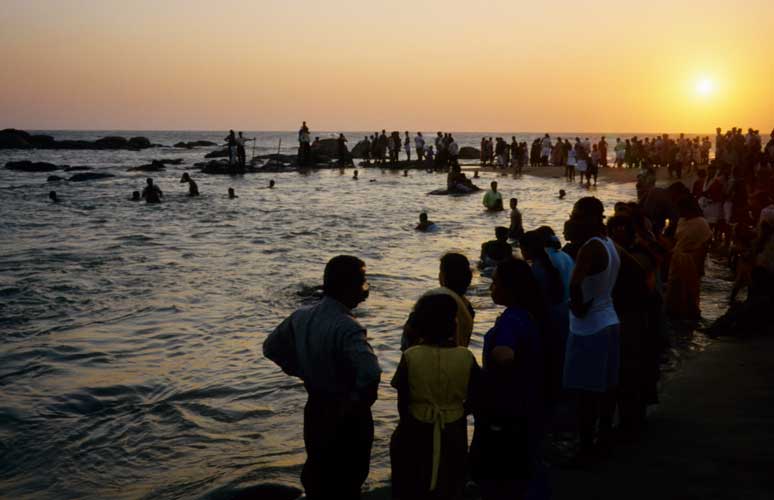
Subject: Bill and Bessie Too are back in the USA
Date: Tue, 05 Mar 2002 16:18:31
Santa Rosa, California
Even at up to 1000 km/hour it was a long ride home, but I had some fun along
the way. From the end at Kanyakumari, I rode back to Trivandrum, the capital of
Kerala state. The small city of 854,000 looked to be a very dull place—the
several museums had all closed due to a state employees strike. But a 200-year old
palace, decorated with wood carvings and full of thrones and other maharaja memorabilia,
was open. Temple festivals were going on too in the city, and I took in a long evening
of Indian dances and songs.
The short cycle ride to the airport should have been uneventful in the quiet
hours before sunrise, but I had forgotten that this was India! Music and movie soundtracks
had blared all night from street-side loudspeakers, and when I stepped out of the
hotel, I found the streets thronged with people. This was the morning when women
came from far and wide to offer rice at temples for the Pongal Festival; women were
setting up little stoves on the sidewalks to cook the rice. I had to take a series
of detours, yet managed to reach the airport ok. From my window seat I watched India’s
green hills and coastline roll by until it all ended at Kanyakumari and I headed
over the Indian Ocean to Sri Lanka. The flight to Bangkok wasn’t until the
next day, so SriLankan Airlines put me up in a package tour resort on the coast.
It seemed the perfect place to do nothing—not my idea of traveling—but
I enjoyed a walk along the coast and pigging out at the buffet dessert tables. Mmmm.
The heat and humidity in Bangkok reminded me that the hot season was beginning.
Nevertheless, lots of travelers hung out on the infamous Khao San Road, especially
at night. I’ve noticed that this old backpackers enclave has gradually moved
upscale over the years, with some of the ramshackle wooden buildings being replaced
by high-rise hotels and restaurants. A Rolls Royce was even parked outside one new
place; I guess not all backpackers still carry backpacks these days! I visited an
old Thai friend in Bangkok and took a river cruise to a Mon pottery village and
some temples—a fine way to see some traditional Thai life.
China Airlines took us across the Pacific in about 14 hours of flying with good
food. At SFO, poor Bessie Too arrived in slightly mangled condition with a broken
brake lever and bent handlebar, only the second time in dozens of flights that my
cycle has been damaged. I suspect that it’s from using gorillas as baggage
handlers at SFO.
If all goes well, I hope to return to the Himalaya with Bessie Too in late summer/early
autumn to tour the valleys and high passes of Ladakh and Himachal Pradesh in India.
Adventures await!
Back to Beginning of Ride
Back to Bill's Exotic Travels


































